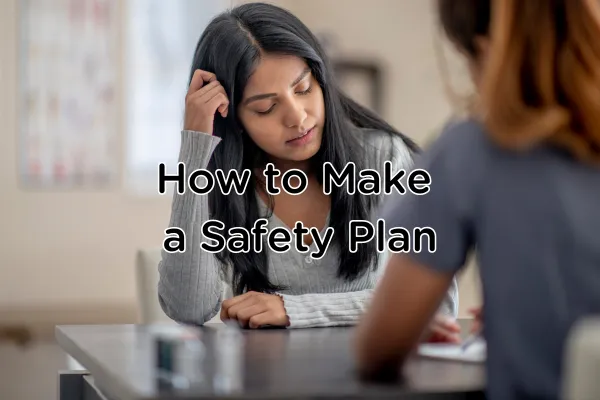General Inquiries: (587) 333-6349 - info@sanostate.com



How to Make a Safety Plan
A safety plan identifies various warning signs for thoughts of suicide and outlines a series of steps involving both internal and external resources to keep the individual safe. - Emily Christensen
Thoughts of suicide pose a significant risk to health and affect more people than you might think. Approximately 1 in 5 people will experience thoughts of suicide at some point in their life. When someone has these thoughts, it can become challenging to keep themselves safe from self-harm and suicide. When these thoughts become overwhelming and difficult to manage, safety plans can be an excellent tool to ensure physical safety and find support.
What is a Safety Plan?
A safety plan is a commonly used tool to support people experiencing thoughts of suicide or self-harm. Mental health professionals, emergency services, and organizations such as the Distress Centre (24-hour crisis support in Calgary and Southern Alberta) utilize safety plans to help ensure the safety of their clients, patients, or callers. A safety plan identifies various warning signs for thoughts of suicide and outlines a series of steps involving both internal and external resources to keep the individual safe. Sometimes, only a few steps of the safety plan need to be used in the event of a crisis.
What are the Steps?
Step One: Warning Signs
This step involves recognizing the different warning signs that may contribute to thoughts of self-harm and/or suicide. Consider what emotions, thoughts, or events typically precede these thoughts. For some people, this may include irritability, isolation from others, or excessive substance use. Documenting these signs can make it easier to understand what may contribute to these feelings and to keep individuals safe once they begin.
Step Two: Internal Coping Strategies
This step employs coping strategies that the individual can use on their own to help distract from thoughts of suicide. When creating this step, it is important to consider any potential roadblocks or barriers to these strategies. By anticipating these challenges, one can select a few internal coping strategies and alternate between them if needed. Activities like taking a shower, going for a walk, or playing with a pet can all help redirect focus and reduce the intensity of overwhelming emotions.
Step Three: Social Contact as a Form of Distraction
If internal coping strategies are ineffective on their own, socialization strategies can help manage thoughts of suicide. In this step, the creator of the plan does not need to share their experience with regard to thoughts of suicide. Socialization is simply meant as a tool of distraction. Some good options for this step include chatting with a friend on the phone, sitting in a coffee shop to see other people, or walking around the community and smiling at passersby. There are many ways to customize this step, from directly interacting with someone to passively interacting with a stranger. It is best to customize this step according to the person’s needs.
Step Four: Using Friends and Family Members as Social Support
This step involves directly communicating with support systems about one’s thoughts of suicide or self-harm. At this stage, the safety plan user informs trusted individuals that they are in distress and need support. They can decide who they feel most comfortable talking to about their thoughts. With the support of friends and family, those struggling with thoughts of suicide can connect with people who matter and receive the support they need.
Step Five: Contact Mental Health Professionals or Agencies
In this step, the safety plan user contacts mental health professionals to receive guided support and ensure their safety during the crisis. This might involve reaching out to the Distress Centre or another suicide helpline, calling 911, or speaking with a counsellor. These resources are equipped to manage crisis situations when safety is at immediate risk and previous steps have not been effective.
Step Six: Restrict Access to Lethal Means
Restricting access to lethal means is a crucial step in ensuring safety. This involves identifying and removing any items that could be used for self-harm or suicide from the immediate environment. This might include securing medications, removing sharp objects, limiting access to firearms, and avoiding vehicle operation. This task may need to be completed by a trusted support person to ensure the safety of the individual in distress. Reducing access to these means can significantly decrease the risk of life-threatening actions.
Conclusion
A safety plan is a proactive step toward managing thoughts of suicide. It provides a structured approach to identifying warning signs, utilizing coping strategies, engaging with social support, and contacting professional help. It’s important to regularly revisit and update the safety plan to ensure it remains effective and relevant. By taking the time to develop a personalized safety plan, individuals can equip themselves with the tools needed to navigate through difficult times and prioritize their safety. Whether for yourself or for someone you care about, a safety plan can be a lifesaving resource.
If you or someone you love is experiencing imminent thoughts of suicide or self-harm, please contact a local distress centre or call 911.
In Calgary and Southern Alberta - Call -1- 403-266-4357
In Edmonton and Area - Call - 1-780-482-4357
Alberta Wide - Call - 1-877-303-2642 (Toll Fee)
💙
Disclaimer
Our content is for informational and educational purposes and is not a replacement for professional advice, diagnosis, or treatment. If you're facing mental health concerns, please seek help from a qualified professional for personalized guidance. Every individual's situation is unique, so use the information here at your discretion. While we strive for accuracy, the field of psychology is ever-evolving, and our content may not always reflect the latest research. Please prioritize your privacy by avoiding sharing personal information in comments or interactions. Your well-being is our top concern, so use our content for educational purposes, but remember to rely on professionals for your specific needs.
Reference
Safety plans to prevent suicide. Centre for Suicide Prevention. (2024, January 31). https://www.suicideinfo.ca/local_resource/safety-plans/
General Inquiries:
Our Locations:
Additional Resources:
About Us:
We strive for excellence in psychological treatment. We are committed to providing professional, caring, innovative, and research-based services.
© 2024 Sano State Taylored Psychology. All Rights Reserved.

